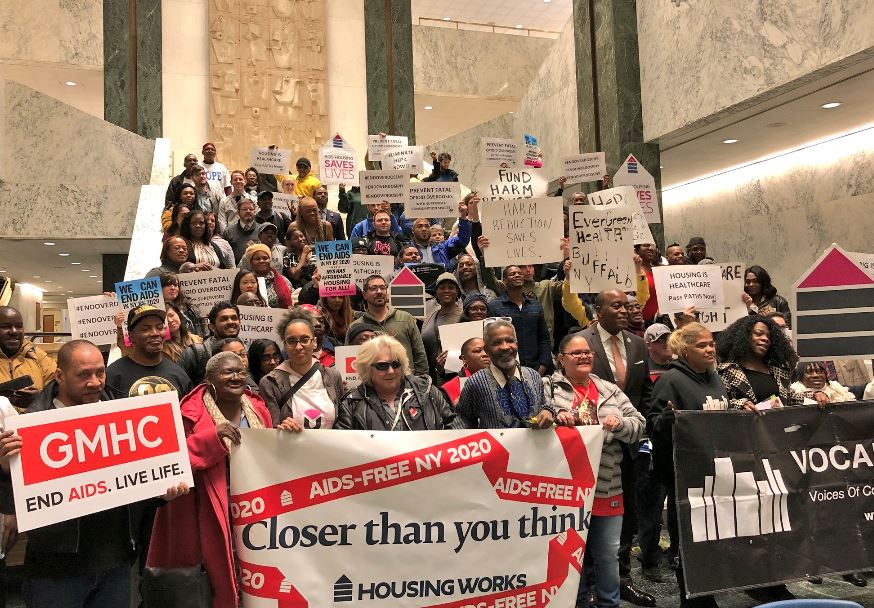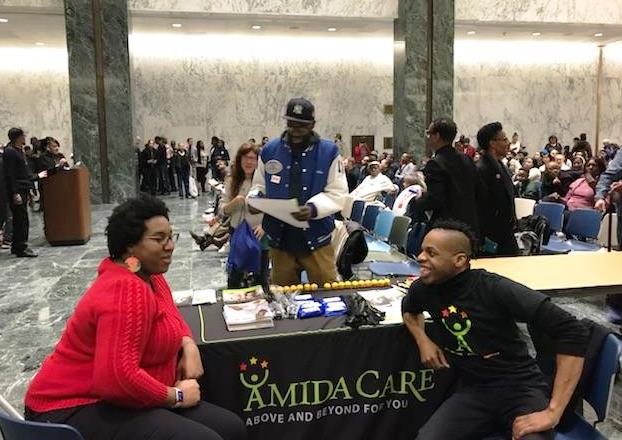Amida Care, Advocates Descend on Albany to Demand More Support for New Yorkers Living with HIV/AIDS
January 23 2018
 Amida Care, New York’s largest not-for-profit Medicaid Special Needs Health Plan (SNP), joined forces with over 60 other organizations from across New York State on January 22 in Albany to advocate for more support for New Yorkers who live with, or are at high-risk of contracting, HIV/AIDS. Increased investment is needed in order to meet the goal of Governor Andrew Cuomo’s Blueprint to End the HIV/AIDS Epidemic (EtE) by the year 2020.
Amida Care, New York’s largest not-for-profit Medicaid Special Needs Health Plan (SNP), joined forces with over 60 other organizations from across New York State on January 22 in Albany to advocate for more support for New Yorkers who live with, or are at high-risk of contracting, HIV/AIDS. Increased investment is needed in order to meet the goal of Governor Andrew Cuomo’s Blueprint to End the HIV/AIDS Epidemic (EtE) by the year 2020.
New York must expand access to rental assistance for individuals living with HIV outside of New York City; increase access to employment opportunities, vocational services, and peer workforce placement; protect Medicaid in the face of federal cuts; and maintain EtE funding commitments to address health disparities and ensure all communities have access to HIV treatment and prevention, including pre-exposure prophylaxis (PrEP).
“Failure to invest in these essential programs and supports will cost us lives and taxpayer money,” said Doug Wirth, President and CEO of Amida Care. “For every new HIV infection we can prevent, we save an estimated $500,000 in lifetime medical costs.”
An estimated 3,700 New Yorkers living with HIV who reside outside of New York City are homeless or do not live in a stable housing environment. This poses a formidable barrier to retaining them in care and providing access to HIV treatment that leads to viral suppression. Viral suppression is key to prevent new HIV infections, since a person living with HIV who has an undetectable viral load cannot transmit the virus to others: “Undetectable equals Untransmittable” (U=U). Providing housing support for 3,700 households in New York State would cost approximately $9 million but would prevent at least 58 new HIV infections each year, resulting in $10.6 million annual savings in the first year by reducing the number of new HIV infections and reducing hospitalizations and emergency room visits.
Access to work is another crucial factor to improve health outcomes. The EtE Blueprint provides extensive recommendations on how job creation can help minimize new HIV infections. Programs like Amida Care’s Workforce Initiative, which trains people living with HIV to use their life experience for living-wage jobs in health navigation and outreach, can have a tremendous positive effect on health and ultimately prevent new HIV infections. An investment in the amount of $3 million would significantly improve access to peer workforce opportunities for New Yorkers living with HIV.
In addition to housing and workforce training, Medicaid remains essential to meet EtE goals. In New York State, it is the single largest source of coverage for people living with HIV, linking people to the health services they need to stay well. Without regular comprehensive care, people with chronic conditions have no choice but to visit the emergency room more frequently, are hospitalized more often, and rack up higher medical bills. All of these costs are ultimately passed on to the government, insurers, and taxpayers. Support for Medicaid in the face of federal cuts remains an essential responsibility for New York if the goal of EtE by 2020 is to be realized.
Populations that are most at risk for contracting HIV–women of color, young men who have sex with men (MSM) of color, and transgender individuals–need better access to preventative methods such as PrEP, a treatment regimen that reduces the risk of contracting HIV by more than 90 percent. It is estimated that PrEP would be appropriate for about 1.2 million people in the U.S., but there are only about 145,000 active prescriptions for HIV prevention use. New York City community-based Sexual Health Clinics have demonstrated success in reaching at-risk communities: 60% of new PrEP users in 2016 were people of color. However, in New York State, according to the EtE Dashboard, 82% of new PrEP users were male, and 37% were white. Clearly, more work needs to be done to ensure that women and communities of color are able to access PrEP. Specifically, a New York State PEP and PrEP monitoring, evaluation, and quality improvement program needs to be developed in order to effectively address the disparities that continue to persist for these communities. The cost of these combined initiatives is approximately $10 million. More funding is also needed for education and awareness building campaigns targeting consumers, social service providers, and medical providers.
By preventing new HIV infections, PrEP not only enables people to live healthier lives, it also prevents hundreds of thousands of dollars spent to treat each individual living with HIV. While it costs about $55,000 over five years for one patient to be on PrEP, it costs nearly 10 times that amount for a lifetime of HIV treatment. Medicaid Managed Care health plans such as Amida Care can play a critical role in offering care coordination and supportive services to help at-risk communities overcome barriers to treatment and prevention. Amida Care ensures that care is tailored to individual needs and connects members to housing, transportation, job training, and other supportive services.
“New York was once the epicenter of the AIDS epidemic, but we have established ourselves as a national leader in efforts to end HIV/AIDS. By making the right investments, we can lead the nation to end the epidemic once and for all,” concluded Wirth, who served on Governor Andrew Cuomo’s EtE Task Force.

